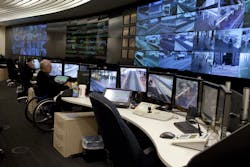For the past decade, Perth, Australia has retained its place on a list of the world’s top 10 most livable cities, as ranked by The Economist Intelligence Unit’s Global Livability Index. The ranking measures lifestyle challenges in 140 cities worldwide across a range of criteria, including healthcare, culture, environment, education, crime and infrastructure.
My employer, the Public Transport Authority (PTA) is the government agency that oversees Western Australia’s public transit infrastructure. Chartered with serving more than two million people in the Perth metropolitan area as well as more than 240 towns across the State, the PTA connects people and places safely and securely. To that end, we have embraced a state-of-the art, integrated mass transit system encompassing rail, bus and ferry services.
Ensuring safe, reliable and flexible transportation without fear or disruption is paramount. After all, public confidence can be gained only through consistent service delivery combined with discernible safety and security provisions. That’s why we have made significant investments in video surveillance and storage technology to meet current expectations and mitigate existing risks while being able to scale capacity to proactively respond to evolving requirements in the future.
As part of PTA’s security focus, we initiated quite an undertaking in 2000, called the Urban Security Initiatives Project (USIP). This push called for the installation of an extensive, closed-circuit television
(CCTV) surveillance and monitoring system encompassing all stations and bus interchanges, along with security lighting, emergency help buttons and a long-line public address (PA) system. Additionally, the project required upgrading PTA’s communications network and storage foundation to accommodate the need to send, receive, store and archive massive amounts of data from the large number of video cameras.
At the time each storage array was able to record and store a maximum of 14 streams per system, limiting the number of cameras that could record. As a result, the original system, quickly reached capacity, which meant that whenever a camera was added, one needed to be removed as the system was unable to cope with additional input streams. And with so many storage arrays and servers to manage and maintain, failures were inevitable.
At the USIP launch in 2003, we had 800 cameras across 70 rail stations and more than 30 related facilities, including bus depots, bus stations, power feeding stations and railcar storage areas. To support these cameras, the surveillance infrastructure included more than 75 storage arrays, each with its own server. Unfortunately, as the system grew so did its limitations.
The system we had in place was capable of recording only six frames per second unless an incident was triggered. Keeping in mind the video needs to be of high enough quality that it will stand up in a court of law, it became apparent that we needed a more scalable storage system with redundancy to meet not only current needs but provide ample capacity and reliability to keep pace with future evolutions.
In 2007, to address increasing server and storage requirements, the PTA deployed a centralized architecture by virtualizing the server fleet backed by two high-availability Fiber Channel storage arrays. Initially, the storage, provided by DataDirect Networks (DDN), boosted capacity to more than 1.5 PBs and improved performance with an average of six GB/s of throughput – more than eight times the demand needed to support the 1,800 cameras we have in place today. Connected to the storage infrastructure are six servers running a video management system in a VMware environment. This gives us the capacity to store multiple petabytes of video surveillance footage in a small data center footprint.
Additionally, we are using DDN’s DirectMon capabilities to ease storage configuration and management, enabling the use of a single application for monitoring and managing explosive growth in both data volume and types. With the new system in place, we’ve been able to capture video streams from thousands of cameras without losing a single frame or stream.
At the end of last year and beginning this year, we upgraded our prior DDN storage to a pair of DDN SFA 12K high-performance storage systems with 3PBs of total capacity and the ability to scale beyond 20PBs of video surveillance capacity to accommodate a surge in data growth resulting from a CCTV system expansion. A portion of the infrastructure refresh also included Cisco UCS blade servers. This allowed us to move from a hybrid analog and digital video management system to a fully digital one.
With this most recent upgrade, we have improved operational control of data-intensive video surveillance footage to ensure passenger and staff safety across Western Australia’s bustling public transit system. What it boils down to is we have enabled our team to extend video surveillance capabilities to encompass 1,800 live and recorded cameras across 72 stations, 234 railcars, 32 facilities and several ferry services. And we’re far from done. We plan to add several hundred more cameras to support growth of the transit system, including a new rail line to the airport, underground bus station in the city center and several new train stations including Stadium Station at the site of the 60,000 seat new Perth Stadium.
We are able to capture all real-time surveillance data at rates of at least 24 frames per second, which provides high-quality footage to assist in detecting, deterring and prosecuting criminal activity. Moreover, ample capacity enables us to retain footage for 31 days.
Essentially, we have a system in place now that allows the use of CCTV to go beyond traditional post-event investigations and take on a bigger role in deterring and detecting security and safety threats as they occur. When our operators see incidents unfolding in real-time, they can use the PA system to address the offender, which often stops the behavior in its tracks without further intervention needed. If an incident does take place, we have a clear, easily accessible recording of what transpired. That makes it easier to apprehend and prosecute offenders. In fact, our ability to produce video evidence of criminal behavior has contributed greatly to the PTA’s 97 percent rate of successful prosecution.
Our video surveillance system has also been credited with reducing graffiti vandalism. In 2010, PTA initiated “Operation Cleanskin,” to detect when graffiti and scratching occurs inside trains, as this type of vandalism costs the organization and Western Australian taxpayers $2.8 million a year. Our system has helped reduce graffiti cleanup hours by more than 70 percent per year.
In addition, our counter-terrorism strategy has been fortified by our innovative CCTV capabilities. Our video surveillance system is a cornerstone of the PTA’s counter-terrorism approach, because it helps monitor activity in real time and take appropriate action. For example, if a suspicious item is left at a train platform, we can pull the footage and see first-hand the circumstances surrounding its appearance. That, in turn, allows us to mobilize as needed.
To provide an example, the ability to mobilize quickly and efficiently has strengthened the PTA’s partnership with local authorities as evidenced by the role we played in helping the Western Australia police service establish a central command center during Commonwealth Heads of Government Meetings (CHOGM). We were able to utilize our extensive fiber optic backbone to transfer stored surveillance data from its system while transmitting video footage from the Department of Main Roads and the city of Perth. Our participation in this crucial state-wide approach ensured additional surveillance footage can be captured in security-sensitive areas designated by the police and then captured, stored and archived without disruption or deletion.
We have also been able to reduce complaints against transit officers by 70 percent in the past five years through our ability to quickly access and review footage of the incident. We can pull footage from any networked computer thanks to our integrated CCTV system and centralized storage.
Finally, the surveillance system helps protect us and our personnel from fraudulent complaints and litigation. We have extensive coverage of stairs, escalators and lifts, allowing us to thoroughly investigate ‘slip, trip and fall’ incidents. By quickly investigating and identifying fraudulent claims, we save countless hours and eliminate unnecessary payouts – which saves taxpayer dollars.
We knew, but through this process, it has become clear just how much video surveillance relies on the element of having a scalable and high performing storage system behind an intelligent video surveillance platform. The storage infrastructure must be able to support the concurrent ingest of video streams from thousands of high resolutions cameras; deliver real-time quality of service to record higher frame rates and video resolutions, without dropping frames under any failure condition; support the ability for analytic software to perform concurrent reads of high resolution video, without affecting the incoming surveillance streams from the cameras; and provide the flexibility to scale cost effectively to larger storage capacities and higher retention periods in the future.
Our view of technology and the crucial role it plays in the safety of our public allowed us to create a truly unique approach surveillance and has established us as a leading public transport agency in Australia. The ever-changing security discipline presents significant technological demands and future research opportunities.
About the Author
Steve Furmedge is a 30 year law enforcement and security professional. During his career with the Western Australian Police Service he spent 13 years with the Bureau of Criminal Intelligence in the specialist field of Covert Operations. After completing university degrees in Judicial Studies and Corporate Security Management, Steve further enhanced his studies in Criminology, Psychology and behavior modification techniques. Furmedge is a recognized expert and key note speaker on Counter Terrorism and security strategies for mass transit and public transport modes. In 2002, Steve was appointed to his current position, and is the Director of Security Services in charge of all security provisions for the Public Transport Authority of WA.


